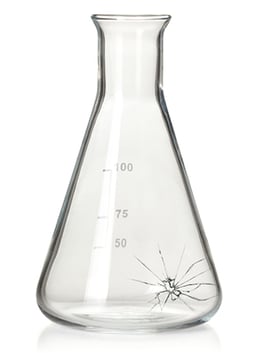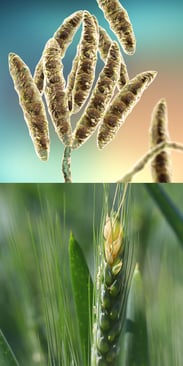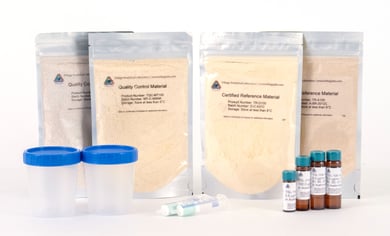Contact Us: 636-239-1521 |
CustomerService@TrilogyLab.com
News
Food and Feed Safety News
MYCO 5W1H: DON and ZONE in Wheat
Carrie Maune
June 01, 2021

 Confident in your current mycotoxin testing plan?
Confident in your current mycotoxin testing plan?
With the 2021 wheat harvest quickly approaching now is the perfect time to ask yourself if you're confident in your current mycotoxin testing plan. Maybe you answered "yes" simply because you have an established quality plan in place that you have followed for years with no major issues. Maybe you answered "no" because you know you need to reevaluated your system but aren't quite sure where to begin. Not sure how'd you to answer? We recently sat down with Carrie Maune, Vice-President of Trilogy Analytical Laboratory, to discuss the basics of contamination of DON (Deoxynivalenol) and ZONE (Zearalenone) in wheat. By discussing the WHO, WHAT, WHEN, WHERE AND WHY of DON and ZONE in wheat we can help to identify where problems may be hiding in your mycotoxin testing plan. By asking the HOW we can help to address any cracks in your quality system before they spread.
We're committed to building quality assurance in your mycotoxin testing system.

WHO:
Q: Who should be concerned about DON & ZONE contamination in their wheat?
A: Anyone who is accepting wheat at a point of purchase site, or who incorporates wheat or wheat products into a product for human or animal consumption should have a plan in place to test for various toxins, including DON & ZONE.
Q: Who should be concerned about DON & ZONE contamination in their wheat?
A: Anyone who is accepting wheat at a point of purchase site, or who incorporates wheat or wheat products into a product for human or animal consumption should have a plan in place to test for various toxins, including DON & ZONE.
WHAT:
Q: What exactly is DON & ZONE?

A: DON and ZONE are both toxic mold metabolites that are toxic to animals and adversely effect human health as well. These compounds are chemicals that molds produce – much like penicillin is produced from a mold, these compounds are also chemicals produced from molds that happen to be toxin to animals, humans instead of being beneficial. DON and ZONE come from fusarium molds that thrive in cool damp weather. This happens in wheat many times in the spring when rains, high moistures and humidity’s are common – especially around the flowering time of the wheat plants.
Q: What should one look for when evaluating the overall quality of their wheat crop?
A: There are a few signs that wheat has been infected with fusarium molds. Typical things to look for are the salmon-colored tips of the kernels and then the kernels that are referred to as “tombstone kernels”. Tombstone kernels are very light weight and many times chalky colored. A low bushel weight at harvest is also an indicator of these lightweight kernels that have been damaged by the molds. The problem with looking at the physical characteristics of the wheat however is that these are only signs of mold damage and don’t give an indicator of the DON or Zearalenone concentration that is present. The only way to know the toxin concentration is with a test that quantitates the actual chemical. Tests can be performed on site with rapid tests or at laboratory facilities to give a quantitative result.
WHEN:
Q: When should organizations be most concerned about wheat contamination of DON and ZONE? What time of year and under what abnormal environmental conditions?
A: Each region is a little different, but plants are most susceptible during the flowering stage. For winter wheat that time comes during the spring. In the Midwest through the upper lakes region winter wheat typically flowers between Mother’s Day and Father’s Day or a little later. The moisture and humidity around the flowering heads make the plants more susceptible to the fusarium molds that produce DON and Zearalenone.
WHERE:
Q: Where are the problem locations for DON and ZONE contamination in wheat in the US?
A: Anywhere wheat is grown is possible, however the major areas for winter wheat are in Arkansas, Missouri, up through the great lakes region and down into the south and eastern states including Mississippi to Georgia and Tennessee and Kentucky thru the Carolinas, Virginia and Maryland.
WHY:
Q: Why is it important to test for DON and ZONE in wheat. What could happen if a large contamination isn’t caught, health-wise and/or legally?
A: It's important to test for DON and ZONE in wheat for several reasons. The first being that these metabolites are toxic to animals. By choosing to not test your crop you risk the health of livestock when they're fed contaminated grains, which depending on concentration can lead to significant financial loss. The other reason it's important to test your wheat is the risk these metabolites pose to human health. Obviously wheat is used as a major food source worldwide. By testing raw materials before their use in manufacturing, you can eliminate the chance of widespread product recalls and public health alerts which can be financially detrimental and lead to long-term brand distrust.
 HOW:
HOW:Q: In general, how can someone establish a plan to ensure the quality of their wheat?
A: A good program to ensure wheat quality is incredibly valuable. It begins with taking an accurate sample and preparing that sample to be as representative of the entire lot as possible. Trilogy has resources available to use as a guide to ensure proper sampling techniques. Next, a solid testing program is critical. Testing can be done on site with rapid kits or reference methods. The results however from either of these testing methods produce the most accurate and trusted results when supported with proper techniques. One technique that is widely used is to run a known concentration naturally contaminated sample along side of the samples that are being tested. This ensures the entire system is working well and generating accurate data with the specific parameters from each day. Everything from the extraction to the final result – including the technician performance is captured in running that known sample. When these few extra steps are taken, the assurance that accurate results are being provided helps minimize any losses from either accepting material that should have been rejected, or rejecting good material that should have been accepted. Additionally, since these toxins have direct effects on human and animal health, as well as having guidance levels issued by the FDA, putting product out into the market with any toxins is devastating to the brand, creates mistrust for the consumer and can cause serious health problems or even death in pets. These known samples can also be used to check external labs for their accuracy on results as well. Simply submit a blind sample as a lab sample and compare the two results.

- Certified Reference Standards
- Analytical Standards
- Certified Reference Materials
- Quality Control Materials
- Rock-It 360 Laboratory Shaker
- Purification Columns
Let's Stay Connected!

